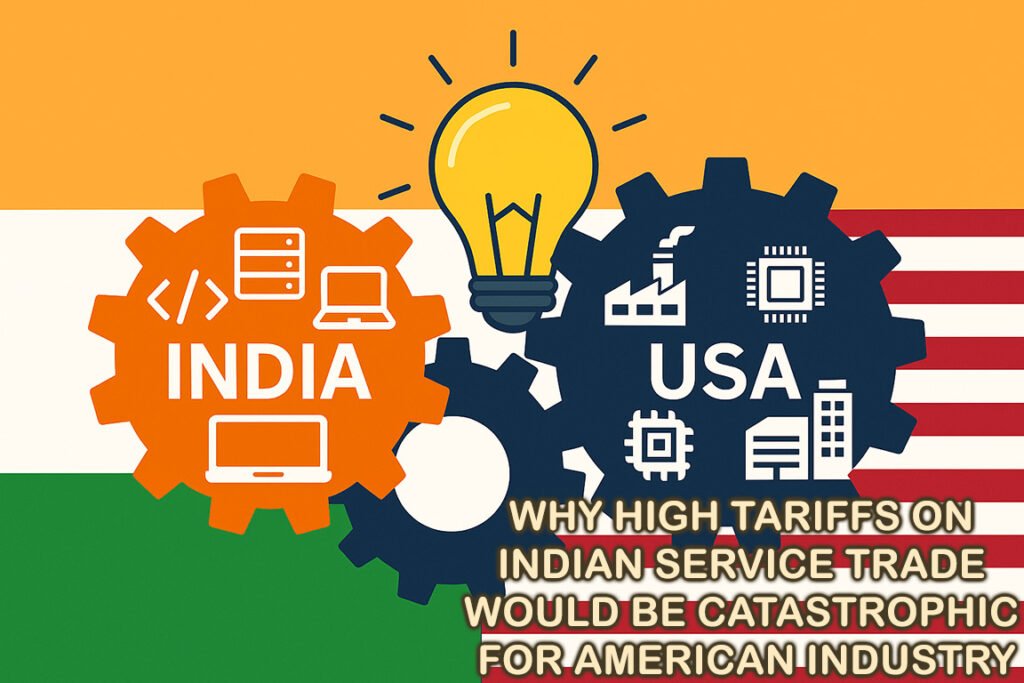
Why High Tariffs on Indian Service Trade Would Be Catastrophic for American Industry
Introduction
For decades, India and the United States have enjoyed a symbiotic services trade relationship. Indian IT firms provided cost-effective, high-quality technology and business services, while U.S. companies tapped into India’s talent pool to scale, innovate, and remain globally competitive. Today, any attempt by Washington to impose high tariffs on Indian service exports would not only disrupt this balance but also undermine America’s own industrial competitiveness, strain bilateral ties, and provoke social and political backlash in India.
The Numbers: India–U.S. Services Trade
- The U.S. runs a services trade surplus with India. In 2022, U.S. services exports to India were $29.6 billion, while imports were $33.5 billion, creating only a narrow gap compared to America’s deficits with other countries.
- U.S. companies earn billions annually through financial services, education, travel, cloud services, and consulting in India’s fast-growing economy.
- Indian IT and business process management (BPM) firms contribute over $200 billion annually to U.S. GDP by supporting Fortune 500 companies, according to NASSCOM.
- Over 75% of Fortune 500 firms rely on Indian service providers or Indian-origin talent for their core IT and engineering backbones.
Tariffs on Indian services would raise costs for U.S. firms across banking, healthcare, logistics, and defence, forcing them to either offshore elsewhere at higher costs or shrink their operations.
Historical and Socio-Economic Context: The Indian Tech Industry and the U.S.
The roots of this interdependence go back to the 1980s–90s. As U.S. firms outsourced Y2K remediation and IT support, Indian firms like Infosys, Wipro, and TCS emerged as reliable partners. Simultaneously, Indian students flocked to U.S. universities, fueling the Silicon Valley boom.
By the 2000s:
- Over 2/3rds of all H-1B visas were going to Indian nationals.
- Today, Indians account for ~75% of STEM graduates on U.S. student visas in critical engineering and computer science fields.
- Indian-origin CEOs now run many of the USA’s top companies, Microsoft (Satya Nadella), Google (Sundar Pichai), Adobe (Shantanu Narayen), IBM (Arvind Krishna), and many others. It is a testimony to the mutual benefits of open service flows and immigration.
How Indians benefited the US
Indian engineers and scientists have been central to U.S. innovation. A few examples:
- Vinod Dham, often called the “Father of the Pentium Chip,” developed Intel’s landmark processors that powered the global PC revolution.
- Ajay Bhatt Invented USB technology, Platform Power Management architecture, and various chipsets.
- Arun Netravali, at Bell Labs, pioneered digital video compression, enabling HDTV, streaming, and today’s multimedia industry.
- Narinder Singh Kapany pioneered the field of fibre optics, which today makes the World Wide Web possible.
- Padmasree Warrior, as CTO of Cisco, led breakthroughs in network architecture.
- Rakesh Agrawal, at IBM, invented key algorithms in data mining that underpin today’s AI and analytics.
- Sabeer Bhatia created Hotmail, which became the first widely used free email client.
- Countless unnamed Indian engineers built large parts of Windows, Google Search, Android, and Apple’s chip design ecosystem.
- Indians account for roughly 1.5% of the American population but pay 5-6% of the income tax. The Globalist
Tariffs that disrupt this pipeline would hurt U.S. innovation more than Indian exports.
The Risk of Indian Public Backlash
India is now a $4 trillion economy with a 1.4 billion population. Anti-American sentiment triggered by unfair tariffs could cause:
- Consumer boycotts of U.S. brands like Apple, Amazon, Coca-Cola, and McDonald’s.
- Procurement barriers for U.S. defence, aerospace, and energy companies seeking contracts in India.
- Pivot to non-U.S. partners: India could deepen ties with the EU, Japan, and Russia for technology cooperation, isolating American firms from the world’s fastest-growing major market.
As former Foreign Secretary Harsh V. Shringla noted, “The India–U.S. partnership is not a zero-sum game; protectionism undermines both nations’ interests.”
Rising Racism in the U.S. and Its Impact
Indian immigrants, approximately 5 million strong in the U.S., are one of the wealthiest, most highly educated diaspora groups. Yet, rising xenophobia and visa backlogs have made life harder.
- Incidents of hate crimes against Indian immigrants have been rising, from Kansas shootings to attacks on Indian students.
- U.S. politicians sometimes use “outsourcing to India” as a scapegoat rhetoric, fueling resentment.
This erodes goodwill in India and makes economic retaliation more likely if Washington were to impose discriminatory tariffs. S. Jaishankar, India’s External Affairs Minister, has repeatedly stressed that “the treatment of Indian nationals abroad is a key element in India’s foreign relations.”
Expert and Industry Voices
- Piyush Goyal (Indian Commerce Minister): “India is not a market that can be taken for granted; tariffs or barriers will hurt not just Indian exporters but American companies reliant on our talent.”
- NASSCOM (2023 report): Indian IT contributes $103 billion annually to U.S. GDP and supports 500,000 U.S. jobs directly.
- Thomas Friedman (NYT columnist): “Indian engineers have been the silent partners of Silicon Valley’s miracle.”
- Bill Gates: “Without India, there is no Microsoft, no Silicon Valley as we know it.”
- Arvind Panagariya (economist): “Trade in services is the most complementary element of India–U.S. relations; tariffs would be self-defeating for America.”
- Sundar Pichai (Google CEO): “India’s tech talent has been critical to our global success and innovation engine.”
Conclusion
Imposing high tariffs on Indian service trade is not a blow to India—it is a self-inflicted wound for the U.S. economy. America’s tech sector, healthcare system, banking backbone, and defence supply chains are deeply intertwined with Indian talent and service flows. Historically, this partnership transformed both nations; socially, it strengthened immigrant communities; strategically, it underpins Indo-U.S. cooperation against China.
A tariff war would not only disrupt industries but also erode trust between two democracies whose cooperation is critical for the 21st century. Instead of protectionism, the U.S. should double down on collaboration, mobility, and innovation partnerships with India.